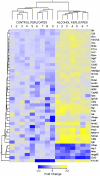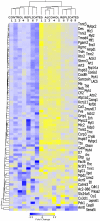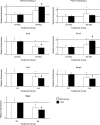Long-term modulations in the vertebral transcriptome of adolescent-stage rats exposed to binge alcohol
- PMID: 20554695
- PMCID: PMC2899847
- DOI: 10.1093/alcalc/agq030
Long-term modulations in the vertebral transcriptome of adolescent-stage rats exposed to binge alcohol
Abstract
Aims: Dangerous alcohol consumption practices are common in adolescents, yet little is known about their consequences on attainment of peak bone mass and long-term skeletal integrity. We previously demonstrated that binge alcohol-exposed adolescent rats showed site-specific reductions in accruement of bone mineral density and bone strength, which were incompletely recovered following prolonged alcohol abstinence. Currently, we analysed the vertebral transcriptome of adolescent rats following alcohol treatment and abstinence to identify long-term molecular changes in the lumbar spine.
Methods: Sixty male adolescent Sprague-Dawley rats were assigned to one of six treatment groups receiving binge alcohol (3 g/kg) or saline i.p., 3 consecutive days (acute binge), 4 consecutive weekly (3-day) binge cycles (chronic binge) or 4 weekly binge cycles followed by a 30-day abstinence period (chronic binge with abstinence). Following treatment, lumbar vertebrae were assayed for global transcriptional changes using gene array technology.
Results: Analysis of the adolescent rat vertebral transcriptome identified clusters of binge alcohol-sensitive genes displaying differential expression patterns starting before bone damage was seen and persisting after alcohol treatment was discontinued. Functional grouping of these gene clusters identified candidate cellular pathways affected following acute and chronic binge treatment, as well as pathways remaining modulated following abstinence.
Conclusions: These results demonstrate that binge alcohol exposure can produce disruptions of normal bone gene expression patterns in the adolescent rat that persist well beyond the period of active intoxication. This data may have relevance to peak bone mass attainment and future risk of skeletal disease in adolescents engaging in repeated binge-drinking episodes.
Figures








Similar articles
-
Binge alcohol treatment of adolescent rats followed by alcohol abstinence is associated with site-specific differences in bone loss and incomplete recovery of bone mass and strength.Alcohol. 2008 Dec;42(8):649-56. doi: 10.1016/j.alcohol.2008.08.005. Alcohol. 2008. PMID: 19038696 Free PMC article.
-
Identification of novel bone-specific molecular targets of binge alcohol and ibandronate by transcriptome analysis.Alcohol Clin Exp Res. 2008 Jul;32(7):1167-80. doi: 10.1111/j.1530-0277.2008.00736.x. Alcohol Clin Exp Res. 2008. PMID: 18537941 Free PMC article.
-
Binge alcohol-induced bone damage is accompanied by differential expression of bone remodeling-related genes in rat vertebral bone.Calcif Tissue Int. 2009 Jun;84(6):474-84. doi: 10.1007/s00223-009-9240-z. Epub 2009 Mar 28. Calcif Tissue Int. 2009. PMID: 19330277 Free PMC article.
-
Neuroimmune activation and myelin changes in adolescent rats exposed to high-dose alcohol and associated cognitive dysfunction: a review with reference to human adolescent drinking.Alcohol Alcohol. 2014 Mar-Apr;49(2):187-92. doi: 10.1093/alcalc/agt164. Epub 2013 Nov 10. Alcohol Alcohol. 2014. PMID: 24217958 Review.
-
Mechanisms of neurodegeneration and regeneration in alcoholism.Alcohol Alcohol. 2009 Mar-Apr;44(2):115-27. doi: 10.1093/alcalc/agn079. Epub 2008 Oct 21. Alcohol Alcohol. 2009. PMID: 18940959 Free PMC article. Review.
Cited by
-
Bone Marrow Multipotent Mesenchymal Stromal Cells as Autologous Therapy for Osteonecrosis: Effects of Age and Underlying Causes.Bioengineering (Basel). 2021 May 17;8(5):69. doi: 10.3390/bioengineering8050069. Bioengineering (Basel). 2021. PMID: 34067727 Free PMC article. Review.
-
Alcohol-related deficient fracture healing is associated with activation of FoxO transcription factors in mice.J Orthop Res. 2016 Dec;34(12):2106-2115. doi: 10.1002/jor.23235. Epub 2016 Jul 29. J Orthop Res. 2016. PMID: 26998841 Free PMC article.
-
Vitamin D and calcium status in South African adolescents with alcohol use disorders.Nutrients. 2012 Aug;4(8):1076-94. doi: 10.3390/nu4081076. Epub 2012 Aug 20. Nutrients. 2012. PMID: 23016133 Free PMC article.
-
Alcohol exposure decreases osteopontin expression during fracture healing and osteopontin-mediated mesenchymal stem cell migration in vitro.J Orthop Surg Res. 2018 Apr 27;13(1):101. doi: 10.1186/s13018-018-0800-7. J Orthop Surg Res. 2018. PMID: 29699560 Free PMC article.
-
Linking metabolic syndrome with low bone mass through insights from BMI and health behaviors.Sci Rep. 2023 Sep 1;13(1):14393. doi: 10.1038/s41598-023-41513-7. Sci Rep. 2023. PMID: 37658154 Free PMC article.
References
-
- Abrams SA. Normal acquisition and loss of bone mass. Horm Res. 2003;60:71–6. - PubMed

